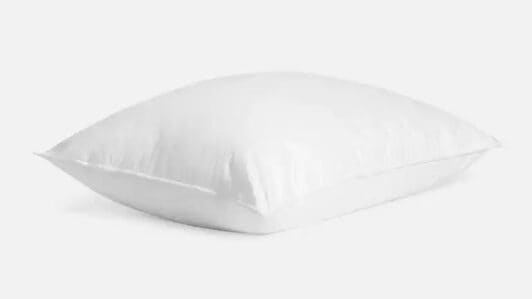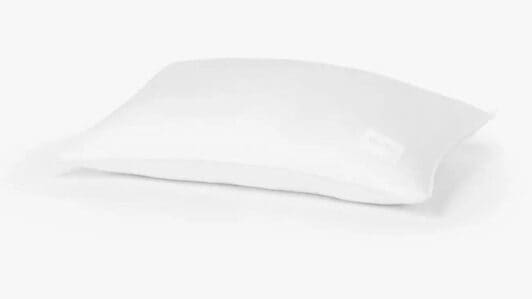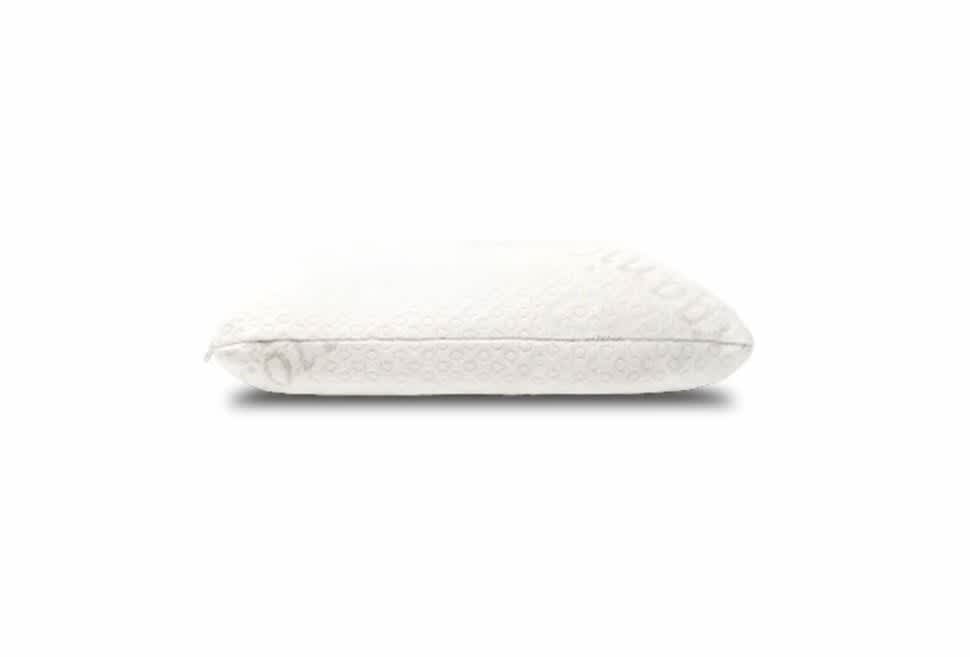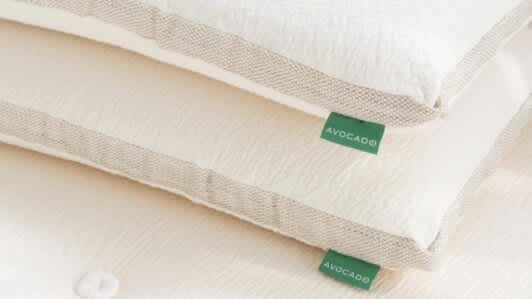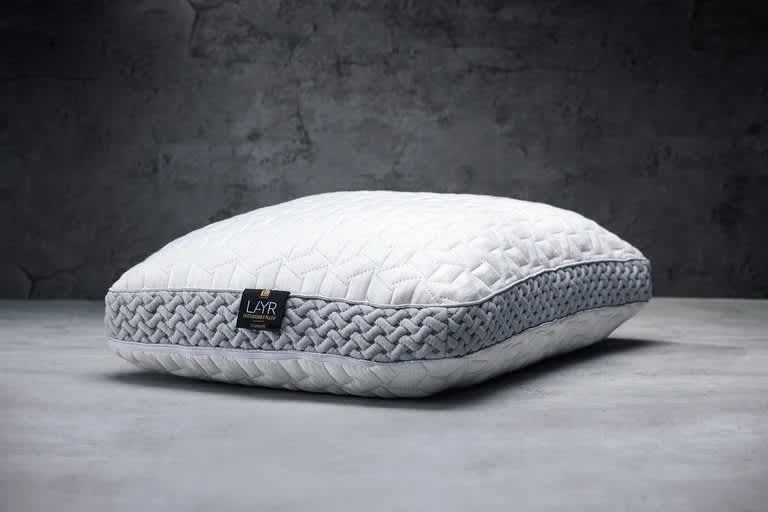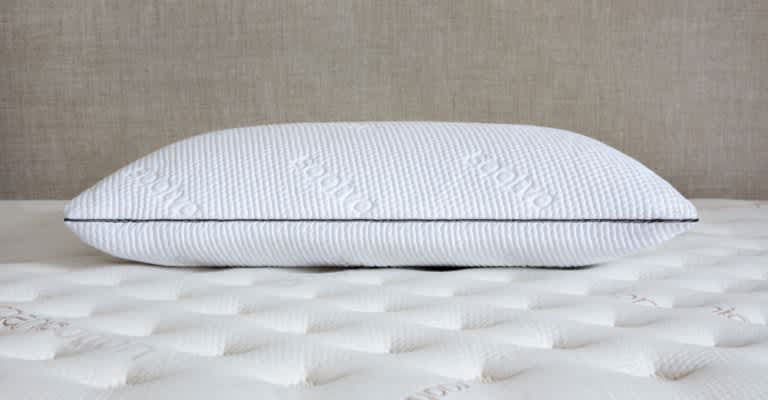On This Page
The Best Firm Pillows for Extra Support
Our Top Picks
-
Best Overall
Brooklinen Down Pillow - Firm -
Best Value
Buffy Cloud Pillow -
Best Luxury
Parachute Down Pillow -
Most Comfortable
Sweet Zzz Buckwheat Pillow -
Best Extra-Firm
Avocado Molded Latex Pillow -
Best Adjustable Firmness
Luxome LAYR Customizable Pillow -
Best for Side Sleepers
Saatva Memory Foam Pillow -
Best for Neck Pain
Tempur-Pedic TEMPUR-Neck Pillow
Best Overall
Highlights
Highlights
- Dual-chamber design features supportive feather clusters cushioned with soft down
- Shell composed of soft cotton sateen
- Shoppers receive discounts for purchasing multiple pillows
Ideal For
- Side sleepers
- People who tend to sleep hot
- Value seekers
Full Details
Best Value
Highlights
Highlights
- Crafted from recycled plastics and sustainably sourced wood
- Fiber fill balances support and cushioning
- Moisture-wicking fiber results in a cool and dry pillow
Ideal For
- Value seekers
- Side sleepers
- Those who prefer moldable firm pillows
Full Details
Best Luxury
Highlights
Highlights
- Contains primarily European white down fill
- 100% cotton sateen shell
- Fill provides plush support
Ideal For
- Sleepers who like to scrunch their pillow into different shapes
- Side sleepers of all weights
- Those who value natural materials
Full Details
Most Comfortable
Highlights
Highlights
- Adjustable fill for customizable loft
- Breathable buckwheat hulls allow significant air circulation
- Durable materials for long lifespan
Ideal For
- Hot sleepers
- Back sleepers of all weights
- Stomach sleepers under 130 pounds
Full Details
Best Extra-Firm
Highlights
Highlights
- Exceptional temperature regulation
- Retains shape well and springs back when the sleeper moves
- Durable and easy to clean
Ideal For
- Side sleepers over 230 pounds
- Back sleepers 130 pounds or more
- Hot sleepers
Full Details
Best Adjustable Firmness
Highlights
Highlights
- Multiple adjustability options enable total personalization
- Bamboo viscose cover helps regulate temperatures
- Comes with three inserts of varying firmness levels
Ideal For
- Sleepers of all weights
- Those who value customization
- Sleepers with changing needs
Full Details
Best for Side Sleepers
Highlights
Highlights
- Two-layer design for balanced support and contouring
- Graphite infusion designed for cooling
- Breathable, machine-washable cotton cover
Ideal For
- Side sleepers over 130 pounds
- Back sleepers under 130 pounds
- Those looking for fluffy, conforming support
Full Details
Best for Neck Pain
Highlights
Highlights
- Unique shape effectively contours to the natural curves of shoulders, neck, and head
- Available in three sizes to fit most body types
- Above-average shape retention and conforming
Ideal For
- Sleepers who experience neck pain
- Side sleepers between 130 to 230 pounds
- Back sleepers over 230 pounds
Full Details
How We Test Pillows
We test pillows against the same set of strict standards that we use for other pillow types, but we pay close attention to several factors that set different pillows apart. In addition to firmness, conforming, and ease of cleaning, we also measure breathability. Many sleepers choose specific materials for their cool feel. To determine how well a pillow regulates temperature, we use thermal sensors that measure heat retention and we try them ourselves too, taking notes on how warm or cool we think a pillow feels after use.
Should You Use a Firm Pillow?
Firm pillows compress less than medium and soft options, limiting how deeply the sleeper’s head sinks in. In contrast, softer pillows compress more, molding to the shape of the head and neck. While firm pillows generally feel more supportive, softer models traditionally provide more cushioning.
Is a Firm Pillow Good For You?
Firm pillows are typically recommended for sleepers interested in ample neck and head support. The pillow’s ability to hold its structure helps keep the head in line with the chest and back, promoting healthy spinal alignment. Good sleep posture is essential because it reduces back and neck strain, minimizes pressure points, and helps the muscles relax more completely.
Although firm pillows typically provide more support, they might not be the right firmness level for your needs. To determine your ideal firmness, consider your body weight, head size, sleeping position, and preferences.
Firm doesn’t necessarily mean thick (though there are pillows that are both). If you’re a stomach sleeper who needs a low-loft pillow but you don’t want anything too soft, there are thin, firm options out there.
Who Is the Best Match for a Firm Pillow?
A firm pillow is often the best match for side sleepers, sleepers who weigh more than 230 pounds, and those who simply prefer a firm feel.
- Side sleepers: Side sleepers have a gap between their head and mattress created by their shoulders resting on the bed. This requires greater support, which a firm pillow with a higher loft can achieve.
- Sleepers who weigh more than 230 pounds: Sleepers who weigh more than 230 pounds are more likely to compress their pillows more when lying down. Firm pillows hold their structure and resist flattening.
- Sleepers who prefer a firm feel: Sleepers who appreciate a more solid feel under their head and neck may prefer a firm pillow. However, they should also pay careful attention to the pillow’s loft to avoid neck strain.
Can a Pillow Be Too Firm?
Depending on the sleeper’s needs and preferences, a pillow can be too firm. This may result in pressure points, neck pain, shoulder pain, or back pain. A pillow that is too firm may push the head forward excessively, resulting in poor spinal alignment. This can strain your neck and cause you to tense your muscles. Meanwhile, a lack of sufficient cushioning could cause pressure buildup.
Stomach sleepers and those weighing under 130 pounds are less likely to find firm pillows comfortable. Unless the pillow is very thin, a firm model can push a stomach sleeper’s head too far back, putting pressure on their neck. Additionally, sleepers under 130 pounds may notice more pressure points on a firm pillow since they don’t sink in as easily as heavier individuals. Smaller individuals may also have narrower shoulders, reducing the firmness and loft necessary for side sleeping.
Sleepers unsure about their pillow preferences and needs may want to invest in an adjustable model. This enables them to change the loft and firmness levels, even if their preferences change nightly.
How Firm Should Your Pillow Be?
The optimal firmness of your pillow depends on several factors, including sleep position, body weight and shape, support needs, and comfort preferences.
Sleep Positions, Pillow Height, and Firmness
Your sleep position should determine your pillow’s loft and firmness level. Sleep position affects the size of the space between your neck and the mattress, and it also influences the angle of your head. For instance, side sleepers experience a larger gap than back sleepers. Meanwhile, stomach sleepers usually sleep with their head turned to the side.
To support spinal alignment, the pillow’s loft and firmness should correspond to the sleeper’s preferred position and accommodate the natural curvature of the neck.
Side Sleepers
Side sleepers typically require a higher pillow loft to fill the gap between their head and the mattress. Medium firm and firm pillows generally provide added support and structure.
Back Sleepers
Back sleepers tend to prefer a medium loft, medium firm pillow to cradle the head and neck without pushing it too far forward.
Stomach Sleepers
Stomach sleepers require lower lofts. Higher lofts can force the head back and to the side, putting stress on the neck and shoulders. Stomach sleepers also prefer soft to medium firmness levels.
Combination Sleepers
Combination sleepers regularly change positions, so adjustable pillows are often ideal. Sleepers can easily change the loft and firmness to meet their nightly preferences. A pillow with a mid-range firmness and loft may also fit most combination sleepers’ needs.
Body Weight and Frame
Body frame, weight, and head size are key determinants of the ideal firmness level. Pillow firmness indicates how well the pillow maintains its shape and structure when a sleeper puts their head on it. Individuals with different body types require varying levels of support.
- Sleepers over 230 pounds: Sleepers who weigh more than 230 pounds often favor firm pillows because they do not compress as easily under their weight.
- Sleepers under 130 pounds: Pillows tend to compress less under the heads of sleepers who weigh under 130 pounds. Therefore, softer pillows are often ideal for this weight group.
Support vs. Comfort
We’ve consistently found that a pillow with the right balance of support and comfort enhances the sleep experience. Fill material is often key to these performance characteristics. The perfect amount of support and comfort varies from sleeper to sleeper, but understanding these criteria can help you decide what’s best for you.
Softer pillows are generally plusher but less supportive, making them popular with sleepers who prioritize cushioning. These pillows usually flatten under the sleeper’s head, providing little support. For side and back sleepers, this can cause neck or back pain due to spinal misalignment.
Firmer pillows tend to offer ample support, but they may feel too solid to some sleepers. A pillow that’s too firm can cause pressure point pain.
Firmest Pillow Types
Fill is integral to a pillow’s overall comfort and support levels. Some fill types are light, airy, and easily compressed, while others have a denser structure that doesn’t collapse under a sleeper’s head. Anyone interested in a firm pillow should consider fills made of polyfoam, memory foam, latex, buckwheat, down, and down alternative.
Polyfoam
Polyfoam is a synthetic material that may be used for shredded or solid core fill. Solid cores are often firmer. Different formulations of polyfoam vary significantly in their feels, so shoppers seeking a firm pillow should pay careful attention to how the manufacturer describes the model. While polyfoam is less dense than memory foam and latex, pillows made of the material are often more affordable.
Memory Foam
Memory foam is a type of heat-responsive polyfoam with greater viscosity, elasticity, and density. In pillows, these traits usually lend to close contouring and notable pressure relief. Shredded and solid memory foam cores are widely available. In our tests, shredded memory foam pillows are usually cooler and more moldable, while solid memory foam models are often firmer.
Latex
Latex fill is available in natural, synthetic, and blended forms. Most firm latex pillows contain a natural, solid latex core, which contours evenly to the head while limiting sinkage. Shredded latex pillows are also available, but they’re less common. Latex pillows tend to retain their shape well, respond quickly to position changes, and resist wear and tear.
Buckwheat
Buckwheat fill contains the hard outer shells of buckwheat seeds, also known as hulls. These hulls make a pillow breathable, dense, heavy, and extra firm. Buckwheat pillows are usually adjustable, allowing sleepers to add or remove hulls to attain their desired loft.
Down
Down traditionally consists of the underbelly feathers of geese or ducks. This fill is well known for its insulation, malleability, and durability. While the material itself is soft, lightweight, and most common in soft or medium pillows, some manufacturers craft firm down pillows by packing the fill more densely.
Down Alternative
Down alternative mimics the softness of down without the use of animal products. Most down alternative fill consists of synthetic, hypoallergenic polyester fibers. Down alternative pillow firmness levels generally range from soft to medium firm.
If you opt for a material like solid memory foam or latex, you can get a firm pillow that still relieves pressure. Sometimes I get ear tenderness while side sleeping and these materials can really make a difference.
Choosing the Best Firm Pillow
The best firm pillow varies by sleeper. Some sleepers need additional support, while others value plushness. Individuals may sleep hot, requiring a breathable, temperature-regulating pillow. Others prioritize pressure relief. Choosing the best pillow for your needs depends on several factors, ranging from sleep position to cost.
- Sleep position: Each sleep position requires a different level of firmness and loft to promote good posture. For instance, side sleepers traditionally benefit from firmer pillows with higher lofts, while stomach sleepers favor softer, lower-loft models.
- Pillow types and materials: Pillow fill material contributes to a pillow’s firmness. Firm pillows often use buckwheat hulls, memory foam, latex, or polyfoam.
- Pillow height (loft): Pillow loft refers to the pillow’s thickness. There are three categories: low loft (under 3 inches), medium loft (3 to 5 inches), and high loft (over 5 inches). Sleeping position and support needs determine the most appropriate loft.
- Firmness: Pillow firmness indicates the pillow’s ability to maintain its shape under pressure. Most models range from soft to firm. The best firmness level depends on a sleeper’s weight, shape, sleep position, and comfort preferences.
- Support: Support indicates how well the pillow holds the head without flattening. This factor is critical for proper spinal alignment and reducing head, neck, and shoulder pain. Firm pillows are usually more supportive than soft pillows.
- Pillow shape: Most pillows come in rectangular standard, queen, and king sizes. However, firm contour and cervical pillows are ergonomically designed for additional neck support.
- Pressure relief: Pressure relief refers to a pillow’s ability to contour to your head, neck, and shoulders. Generally, firm pillows provide less pressure relief than soft pillows. However, materials that conform to the sleeper’s head, like memory foam and latex, often balance pressure relief and support.
- Moldability: Moldability indicates the ability to adjust the shape of the pillow to your needs. Although firm pillows with solid foam cores are not moldable, those with shredded foam, down, or down alternative usually are.
- Temperature regulation: Temperature-regulating pillows remain cool as you sleep, making them ideal for hot sleepers. Because firm pillows with solid cores are usually denser, they often retain more heat. If you want a firm yet temperature-regulating pillow, we suggest considering a buckwheat or latex model.
- Cost: Firm pillow prices vary based on several factors, including materials, quality, construction, and features. However, firm pillows tend to be higher in price because they typically consist of high-quality, durable materials.
Explore More Pillows
If you’re looking for a particular type of pillow, check out our other guides below.
